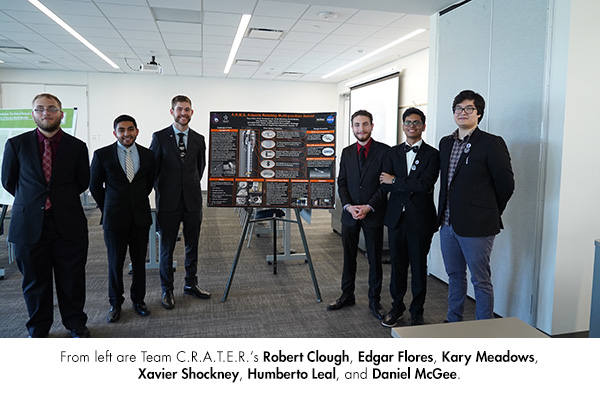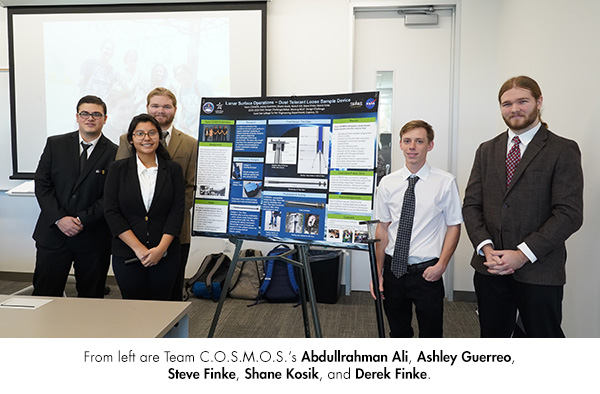For the first time, Lone Star College-CyFair sent two engineering student teams to the Texas Space Grant Consortium (TSGC) Fall 2019 Design Challenge, where they took first- and fourth-place overall in the Top Design Team category.
Team C.R.A.T.E.R. (Cultivating, Retrieving, Analyzing and Testing Experimental Rocks) also took first in Best Peer Review and second in Best Poster and Best Oral Presentation. The second team - Team C.O.S.M.O.S. (Collecting and Obtaining Scientific Moon Objects and Specimens) – also took third in Best Poster and fifth in Best Peer Review. Both teams were among the top teams in Best Model/Display.
The overall TSGC honor not only earned the 11 students on these two teams $8,000 in scholarships, almost half of the total $20,000 awarded, but it was LSC-CyFair’s fourth team to compete and to win the TSGC challenge.
LSC-CyFair’s freshman and sophomore students were competing against mostly senior teams from four-year universities with more years of engineering and mathematics experience, yet LSC-CyFair continuously ranked in the top five in all categories.
“The fact that we did that is amazing,” said Humberto Leal, Team C.R.A.T.E.R.’s team lead. “It shows all the work we’ve done here has paid off."
And as in the previous two years, LSC-CyFair students are dual participants in the TSGC Design Challenge and the NASA Micro-g NExT Program Design Challenge. LSC-CyFair had two teams among 19 teams statewide presenting their work at TSCG, and both teams advanced to the next level of the nationwide Micro-g NExT Design Challenge.
Edgar Flores of Team C.R.A.T.E.R. said “We have a very unique opportunity to work side-by-side with NASA scientists and engineers to try and tackle some of the challenges that comes with space exploration.”
This spring both student teams will work to formally manufacture prototypes of their tools in metal and put their award-winning designs to the test at NASA’s Johnson Space Center next summer.
“We are one of two community colleges in the nation chosen this year to test their tools at NASA’s Neutral Buoyancy Lab and to have both of our teams selected is a major accomplishment,” said LSC-CyFair Professor Jared Cammon, who co-advises the teams with Professor Dr. Yiheng Wang. “These students have put in a lot of hard work and Dr. Wang and I are very proud of what they have achieved.”
Dr. Wang said most of this year’s design challenge topics are related to the moon due to the Artemis program in which NASA plans to have the first woman and next man land on the moon by 2024. Both student teams are working to address issues posed in past Apollo missions as they develop tools for lunar surface operations. The main challenge for both teams is that their tools must be lunar dust tolerant, which is abundant, adhesive and corrosive.
Joining Leal and Flores on Team C.R.A.T.E.R. are Xavier Shockney, Daniel McGee, Kary Meadows and Robert Clough. They are creating a pivot mechanism which can then be attached to different handles and tools that can rotate and lock at set angles.
With the intricacies of their device, the numerous design iterations and the long hours put into the process, Shockney said “To finally see it come together and actually work was a moment of beauty.”

Team C.O.S.M.O.S consists of Ashley Guerreo (team lead), Shane Kosik, Abdullrahman Ali, Steve Finke and Derek Finke. They are developing a hand-held loose sample collector that allows astronauts to collect samples from the lunar surface without bending over.
“The success of these new teams at TSGC really didn't come as a total surprise,” said Professor Dr. Wang, who has incorporated the design challenge as part of an honors engineering class – the only one in the LSC system. “Our past teams were all voluntary and would have already learned some necessary design skills before taking on the project. But our current two teams have had to learn the skills while working on the project and trying to meet many challenging deadlines set forth by TSGC and NASA Micro-g. The students did excellently, and I consider this a successful implementation of real-world challenges into our engineering curriculum.”

For information about the LSC-CyFair Engineering Program, visit LoneStar.edu/engineering-dept-cyfair. Registration is also open for spring classes, which start Jan. 13. For information, go to LoneStar.edu/registration.
